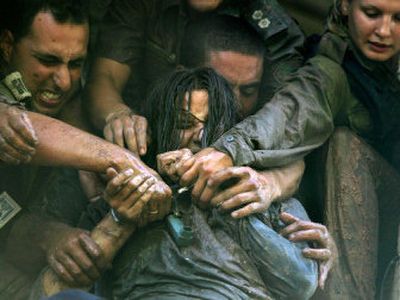Israeli troops evict holdouts, completing Gaza withdrawal

SANUR, West Bank – Israeli forces armed with riot gear, saws and wire cutters evicted militant holdouts from two Jewish settlements Tuesday, completing Prime Minister Ariel Sharon’s historic withdrawal from the Gaza Strip and a corner of the West Bank.
The relative ease and lack of violence with which Israel pulled out of the 25 settlements in just a week was a stinging setback to Israel’s ultra-nationalist movement, which for months had mounted vocal and dramatic resistance.
Palestinian and Israeli leaders as well as President Bush said the pullout – the first time Israel has abandoned territory Palestinians claim for their future state – opened new opportunities for peace negotiations.
Mobilized for the final push, about 10,000 soldiers and police overwhelmed extremists protesting the pullout in the West Bank settlements of Sanur and Homesh. SWAT teams sprayed a fire hose on dozens of extremists, sliced through steel bars of a shuttered seminary and bulldozed a barbed-wire barricade to storm rioters pelting troops with eggs and tin cans.
The settler evacuations concluded the major piece of the unilateral pullout Sharon envisioned 18 months ago, aimed at reducing friction with the Palestinians, easing Israel’s military burden, and tightening its hold on the West Bank heartland where most of the 240,000 Jewish settlers live.
Israel said homes in the abandoned settlements will be destroyed in 10 days, part of an agreement with the Palestinians.
In Gaza, the Israeli government – after quiet consultations with the United States and the Palestinians – decided to demolish the private homes used by Jewish settlers, many of them single-family villas, and to leave most public buildings intact.
The Palestinians felt the homes were inappropriate for their housing needs in overcrowded Gaza, and plan to build high-rise apartment buildings in their place. In addition, many ordinary Gazans feared that corrupt Palestinian politicians and their cronies would appropriate settler villas.
Bulldozers leveled villas and cottages in Ganim and Kadim – the first demolitions in the West Bank – after settlers there left Tuesday of their own accord. Destruction of houses in the 21 Gaza settlements were already under way.
In Gaza, explosions were heard late Tuesday in the abandoned settlement of Dugit, where Palestinian officials said Israelis had advised them they would be blowing up buildings and installations. With the civilians gone, Israel must destroy its military bases before staging its own withdrawal – within a few weeks – and end the 38-year occupation of the coastal strip.
Israeli doves, who said little while Sharon battled his own hawkish party to push through the withdrawal plan, were jubilant. “This is the beginning of a process we always regarded as necessary. The hope is the state of Israel is coming back to sanity,” said Tsali Reshef, a leader of the Peace Now movement.
Palestinian leader Mahmoud Abbas telephoned Israeli President Moshe Katzav to congratulate Israel on its “courageous step” of leaving Gaza. A day earlier, Abbas telephoned Sharon and the two leaders agreed to meet soon.
Bush said Monday the pullout has cleared the way for the resumption of peacemaking. “In the heart of the Middle East a hopeful story is unfolding,” he said.
The West Bank evacuations began shortly after dawn when columns of troops entered Sanur and Homesh. Resistance there was staged largely by 1,500 Israelis from outside the West Bank – some of them youths known for their extremism and rejection of the Israeli government’s authority.
“Everyone knew we wouldn’t win, that the army brought big forces here. But we came to demonstrate determination,” said Ido, a 17-year-old from the southern Israeli town of Sderot.
For many Israelis, the evacuation of the West Bank settlements – in the heart of the biblical Land of Israel – was particularly painful, and authorities feared extremists would turn violent. They did not, and troops persuaded most protesters to leave without a struggle.
“Rabbis were present at all the flashpoints and they lowered the flames,” said northern commander Maj. Gen. Yair Naveh.
The toughest resistance came at a Homesh seminary, where protesters barricaded themselves on the roof. Resisters locked arms but did not struggle when troops placed them into the shovel of a bulldozer and lowered them to the ground.
Below, troops sawed through the window bars and main gate of the building to carry out protesters.